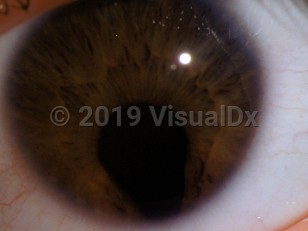Coloboma - External and Internal Eye
Alerts and Notices
Important News & Links
Synopsis

Derived from the Greek word for defect, a coloboma (plural colobomata or colobomas) is a genetic defect resulting from failure of an embryonic structure known as the choroid fissure (also known as the optic or embryonic fissure) to fuse, resulting in a hole in parts of the eye such as the iris, retina, choroid, retina, or optic nerve. Colobomas can be isolated or syndromic and have an extremely varied presentation. They can be found bilaterally or unilaterally and can result in no visual change or severe vision loss, depending on location. They can be cosmetically obvious with no effect on visual acuity when affecting the iris. On the other hand, when located further posteriorly, they may require a dilated ophthalmologic exam for identification and can result in severe vision loss. It is a relatively rare condition, affecting 1:10 000 individuals without racial or ethnic predilection.
The embryonic fissure develops as an invagination of the optic vesicle and leaves a gap inferonasally to allow the entrance of the hyaloid artery. Fusion begins at the equator and then proceeds anteriorly and posteriorly. As such, colobomas are often found inferonasally and either in the anterior structures or posterior structures of the eye. This process is complete by the fifth week of gestation. Other relevant etiologic factors include nutrition and environmental exposure. Rat fetuses made deficient in retinol (Vitamin A) fail to close the optic fissure; this was prevented by supplementing with retinol. Colobomas can also be seen in children with fetal alcohol syndrome. Genetically, the regulation of globe development is complex. Recently, zebra fish deficient in FGF-Ras pathway components have been shown to develop ocular colobomas. Colobomas have been seen to demonstrate autosomal dominant, autosomal recessive, and X-linked inheritance in family studies.
Some syndromes associated with eye colobomas include CHARGE syndrome, cat eye syndrome, Patau syndrome, and Treacher-Collins syndrome. Occasionally, colobomas co-present with microphthalmos, a condition in which one or both eye(s) is abnormally small.
Colobomas of the eyelid are also holes in orbital structures, but arise from failure of fusion of epidermal progenitor cells, not components of the choroid fissure. Colobomas of the upper eyelid in particular can result in severe exposure keratopathy in infants. They can be seen as a component of the Fraser or Goldenhar syndromes.
The embryonic fissure develops as an invagination of the optic vesicle and leaves a gap inferonasally to allow the entrance of the hyaloid artery. Fusion begins at the equator and then proceeds anteriorly and posteriorly. As such, colobomas are often found inferonasally and either in the anterior structures or posterior structures of the eye. This process is complete by the fifth week of gestation. Other relevant etiologic factors include nutrition and environmental exposure. Rat fetuses made deficient in retinol (Vitamin A) fail to close the optic fissure; this was prevented by supplementing with retinol. Colobomas can also be seen in children with fetal alcohol syndrome. Genetically, the regulation of globe development is complex. Recently, zebra fish deficient in FGF-Ras pathway components have been shown to develop ocular colobomas. Colobomas have been seen to demonstrate autosomal dominant, autosomal recessive, and X-linked inheritance in family studies.
Some syndromes associated with eye colobomas include CHARGE syndrome, cat eye syndrome, Patau syndrome, and Treacher-Collins syndrome. Occasionally, colobomas co-present with microphthalmos, a condition in which one or both eye(s) is abnormally small.
Colobomas of the eyelid are also holes in orbital structures, but arise from failure of fusion of epidermal progenitor cells, not components of the choroid fissure. Colobomas of the upper eyelid in particular can result in severe exposure keratopathy in infants. They can be seen as a component of the Fraser or Goldenhar syndromes.
Codes
ICD10CM:
Q13.0 – Coloboma of iris
SNOMEDCT:
93390002 – Congenital ocular coloboma
Q13.0 – Coloboma of iris
SNOMEDCT:
93390002 – Congenital ocular coloboma
Look For
Subscription Required
Diagnostic Pearls
Subscription Required
Differential Diagnosis & Pitfalls

To perform a comparison, select diagnoses from the classic differential
Subscription Required
Best Tests
Subscription Required
Management Pearls
Subscription Required
Therapy
Subscription Required
References
Subscription Required
Last Updated:01/11/2023

